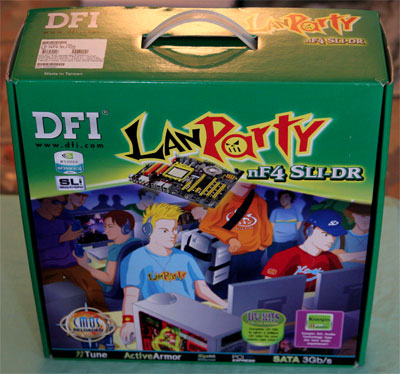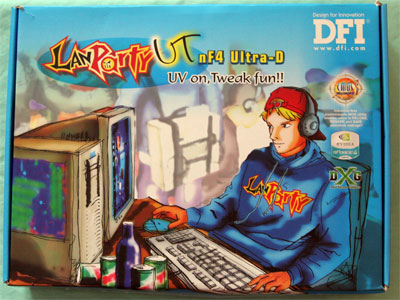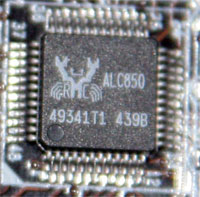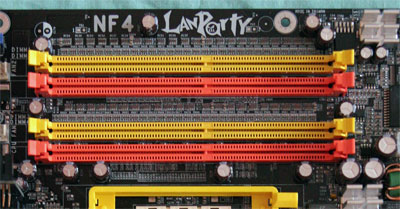DFI nForce4: SLI and Ultra for Mad Overclockers
by Wesley Fink on February 5, 2005 9:30 AM EST- Posted in
- Motherboards
Basic Features: DFI nForce4
DFI uses the same PCB for all nForce4 models. This assures that the overclocking capabilities of all the nForce4 boards are the same. In fact, all boards use the same BIOS. The 3 DFI nForce4 models are:- LANParty nF4 SLI-DR
- LANParty UT nF4 SLI-D
- LANParty UT nF4 Ultra-D
Models with the SLI name feature the nVidia nForce4 SLI chipset, while those with Ultra use the nF4 Ultra chipset. All boards feature dual PCIe slots, and the "R" in the SLI-DR adds Silicon Image 3114 4-drive SATA RAID. The two LANParty UT models are identical except one uses the SLI Chipset and the other uses nF4 Ultra.

We tested production models of the top and bottom of the DFI nForce4 lineup, and we can report that performance of these two models was exactly the same in all our benchmarks. Your choice, therefore, should be based on the SLI/Ultra choice and other features. In addition, those who are willing to mod a chip can make a minor change to the $140 Ultra-D board and convert it into an SLI chipset with SLI performance identical to the top line SLI boards. Details on this mod are available at Morphing nForce4 Ultra into nForce4 SLI.
| Specification | DFI LANParty nF4 SLI-DR | DFI LANParty UT nF4 Ultra-D |
| CPU Interface | Socket 939 Athlon 64 | |
| Chipset | nForce4 SLI (single chip) | nForce4 Ultra (single chip) |
| Bus Speeds | 200MHz to 456MHz (in 1MHz increments) | |
| PCI/AGP Speeds | Asynchronous (Fixed) | |
| PCI Express | 100MHz to 145MHz in 1MHz increments | |
| Core Voltage | Auto, 0.8V to 1.55V in 0.025V increments (Normal) PLUS *104%, 110%, 113%, 123%, 126%, 133%, 136% (Special - to 2.1V) |
|
| CPU Startup Voltage | Startup, 0.825V to 1.550V in 0.025V increments | |
| DRAM Voltage | 2.5V to 3.2V in 0.1V increments (3V jumper) 2.5V to 4.0V in 0.1V increments (5V jumper) |
|
| Chipset Voltage | 1.5V, 1.6V, 1.7V, 1.8V | |
| Hyper Transport Ratios | Auto, 1.0, 1.5, 2.0, 2.5, 3.0, 4.0, 5.0 | |
| LDT Bus Transter | 16/16, 16/8, 8/16, 8/8 | |
| LDT Voltage | 1.2V, 1.3V, 1.4V, 1.5V | |
| CPU Ratios | Auto, 4x to 25x in 0.5x increments | |
| Cool'n'Quiet MAX FID | Auto, 8.0 to 13.0 in 0.5x increments | |
| DRAM Speeds | Auto, 100, 120, 133, 140, 150, 166, 180, 200 | |
| Memory Command Rate | Auto, 1T, 2T | |
| Memory Slots | Four 184-pin DDR Dual-Channel Slots Unbuffered ECC or non-ECC Memory to 4GB Total |
|
| Expansion Slots | 2 x16 PCIe Slots 1 x4 PCIe 1 x1 PCIe 2 PCI Slots |
|
| Onboard SATA | 4-Drive SATA by nF4 PLUS 4-Drive SATA by Sil31144-Drive SATA by nF4 |
|
| Onboard IDE | Two Standard nVidia ATA133/100/66 (4 drives) | |
| SATA/IDE RAID | 4-Drive SATA PLUS 4-Drive IDE (8 total) Can be combined in RAID 0, 1 PLUS 4-Drive SATA by Sil3114 Sil3114 Raid 0, 1, 5 |
4-Drive SATA PLUS 4-Drive IDE (8 total) Can be combined in RAID 0, 1 |
| Onboard USB 2.0 IEEE-1394 | 10 USB 2.0 ports supported nF4 2 1394A FireWire ports by VIA VT6307 |
|
| Onboard LAN | Dual Gigabit Ethernet PCIe by Vitesse VSC8201 PHY PCI by Marvel 88E8001 |
|
| Onboard Audio | Karajan Audio Module based on Realtek ALC850 8-Channel codec with 6 UAJ audio jacks, CD-in, front audio, and coaxial SPDIF In and Out |
|
| Other Features | Power and Reset momentary switches | |
| BIOS | Award 2/01/2005 | |
All of the new DFI boards are based on either the nForce4 SLI or the nForce4 Ultra. More information on nForce4 is available at:
Morphing nForce4 Ultra into nForce4 SLI
NVIDIA's GeForce 6 SLI: Demolishing Performance Barriers
FIRST LOOK: Gigabyte K8NXP-SLI
FIRST LOOK - nForce4: Gigabyte K8NXP-9
nForce4: PCI Express and SLI for Athlon 64
NVIDIA SLI Performance Preview with MSI's nForce4 SLI Motherboard
The DFI boards all support the full range of nVidia nForce4 features including nVRAID, Active Armor, SATAII 3Gb/s drives, NCQ, any-drive IDE/SATA Raid, PCIe Gigabit LAN by a PHY Ethernet chip (plus an additional PCI Gigabit LAN), and the nTune utility.
Packaging for the full LANParty nF4 SLI-DR is typical LANParty.

It is a huge package with a motherboard, UV cables, a system carrier, a Front-X box, and even UV sheathing for your system cables.
The UT provides a more modest package.

The UT does include most of the same features and accessories found in the LANParty SLI-DR, however. The board is the same except it is based on the Ultra chipset instead of SLI and the Ultra-D does not have the additional 4 SATA ports provided by the Silicon Image 3114. You still get the UV cables, and even the same Karajan Audio Module. The missing accessories are the system carrier, Front-X (which will be very important to some) and cable sheathing. If performance is what matters to you, then you can choose any of the new DFI nForce4 boards and then decide what additional features and accessories matter to you.
DFI has continued with the Karajan Audio Module first introduced on their LANP arty 925x. However, we wish that DFI had been able to use the High Definition ALC880 or a similar chip instead of the more common ALC850. The Karajan Module isolates audio for best signal-to-noise ratio and high definition chip benefits most from this isolation.

The Realtek ALC850 7.1 audio chip has appeared on many recent motherboards. This 8-channel audio codec is fully AC '97 2.3 compliant and features 16-bit 8-channel audio and auto-jack sensing with support for a full range of analog and digital IO. The Karajan Module includes both SPDIF in and out coaxial connectors on the rear IO panel. There is also an on-board SPDIF connector for an optical cable.
The ALC850 Codec provides four pairs of stereo outputs, with 5-Bit volume controls and multiple stereo and mono inputs, along with flexible mixing, and gain and mute functions. Two 50mW/20ohm headset audio amplifiers are integrated at Front-Out and Surround-Out, and both amplifiers are selectable for Front-Out, Line-In and Mic-In as a Universal Audio Jack.
You can find more information on the recently released ALC850 atRealtek.

DFI provides a full selection of rear I/O ports. These include 6 programmable audio mini jacks plus coaxial SPDIF in and out connectors to support the Realtek ALC850. The back panel also includes PS2 mouse and keyboard, 1 standard Firewire (IEEE1394a), 6 USB, and two RJ45 Gigabit Ethernet. There are no rear ports for a Parallel Printer or serial devices, but there is an onboard header for an external serial device - an IR header.

On "R" models, like the DFI LANParty nF4 SLI-DR, DFI uses the Silicon Image 3114 SATA controller to add 4 more SATA ports to the 4 already provided by the nVidia nForce4 chipset. The Sil3114 ports can be combined in RAID 0, 1, or 5. RAID 5 can be implemented on this controller with 3 hard drives.

The four DIMM slots support up to 4GB of up to DDR400 memory in a Dual-Channel memory configuration. Dual-Channel 1 is DIMMs 1 and 3, and Dual-Channel 2 is DIMMs 2 and 4. DFI specifies support for both ECC and non-ECC unbuffered memory. Contacts at DFI advise that best overclocking is achieved with the dual-channel DIMMs in Sockets 2 and 4.










114 Comments
View All Comments
bigtoe36 - Wednesday, February 2, 2005 - link
regarding the NF3 939 i hear NF3 may disapear soon so we may never see an AGP version of this board.Wesley Fink - Wednesday, February 2, 2005 - link
DFI has advised that the final nF4 product line will consist of 3 models. The information on page 2 has been revised to reflect the latest information.bigtoe36 - Wednesday, February 2, 2005 - link
The extra molex is to add extra power to the board especially when using 2 video cards.The chipset fan is very quiet and does work quite well. When stressed the chipset does get quite warm though but I have seen no instability on my boards here and all use stock chipset cooling.
The board will work with 20 and 24 pin ATX connectors.
The SLI bridge can only be sold with SLI boards, you will be able to but it seperately though.
jwix - Wednesday, February 2, 2005 - link
I've been waiting and waiting and waiting for this board. Finally, Anandtech posts this review late last night just as someone posts in the forum that the board is stocked at ZZF. I surf to ZZF. Indeed, the board is in stock. I quicky read the review then return to ZZF to buy. Board is out of Stock. *sigh* I'm betting the price of this board goes up before it goes down.LoneWolf15 - Wednesday, February 2, 2005 - link
A good review overall. Some questions I'd have liked to see answered though:a)As others have said, what is the 5.25" Molex power connector on the board for?
b)ATX power connectors - does the board require the 24-pin, or, like other boards, will a 20pin +4pin P4 connector run it just fine?
c) I'd have liked a little more detail on the maglev chipset fan, was it noisy, the design, etc. I'm being picky, but it's a new feature and all of us get annoyed when a northbridge HSF fails, especially if it's in a location where you can't replace it with just anything due to expansion cards.
d)Question on the SLI finger-board: It seems like it doesn't come with the non-SLI boards, if it doesn't, how useful is it to be able to convert this to SLI? I've not seen retailers selling them separately.
I like the boards. Only minor gripe is, I still need an onboard serial port, I use it for things like configuring a router now and again. Hopefully they include a backplate for it at least, though I'd doubt it.
Burbot - Wednesday, February 2, 2005 - link
#22: It would be a good idea to look back at history of industries. When was the last time a sprinter broke a record by 8%? Probaby in first days of organized sprint. When was the last time processor speed increased by 8%? Every A64 200MHz speedbump gave slightly bettter improvements. 8% is difference between 2.4 and 2.6 GHz Athlon FX. Does one demolish the other? Or it is "merely" a fair improvement? I side with the latter.I do not want to diminish DFI effort, but I'd reserve "demolished" to huge improvements, as in "that A64 machine demolishes my Duron box".
lsman - Wednesday, February 2, 2005 - link
#14. it provides extra current when under SLI mode so its more "stable"Aquila76 - Wednesday, February 2, 2005 - link
I've said it before, I'll ask for it again:SLI Mobo Roundup.
Please.
byvis - Wednesday, February 2, 2005 - link
The board is nice, but not outstanding, incredible, top performing, etc... Jesus AnandTech I have never seen you so biased. I hope that the benchmarks don't lie. Poor preview, poor...Wesley Fink - Wednesday, February 2, 2005 - link
ChineseDemocrcyGNR - Thank you for all your replies to reader's questions.#22 - Good analogy and a very accurate descrip-tion of breaking records at the top end. New CPU's are often hyped to the heavens and often they don't even do 8% more performance than the one they replace. Breaking new ground at the top is quite different than 8% in the middle.